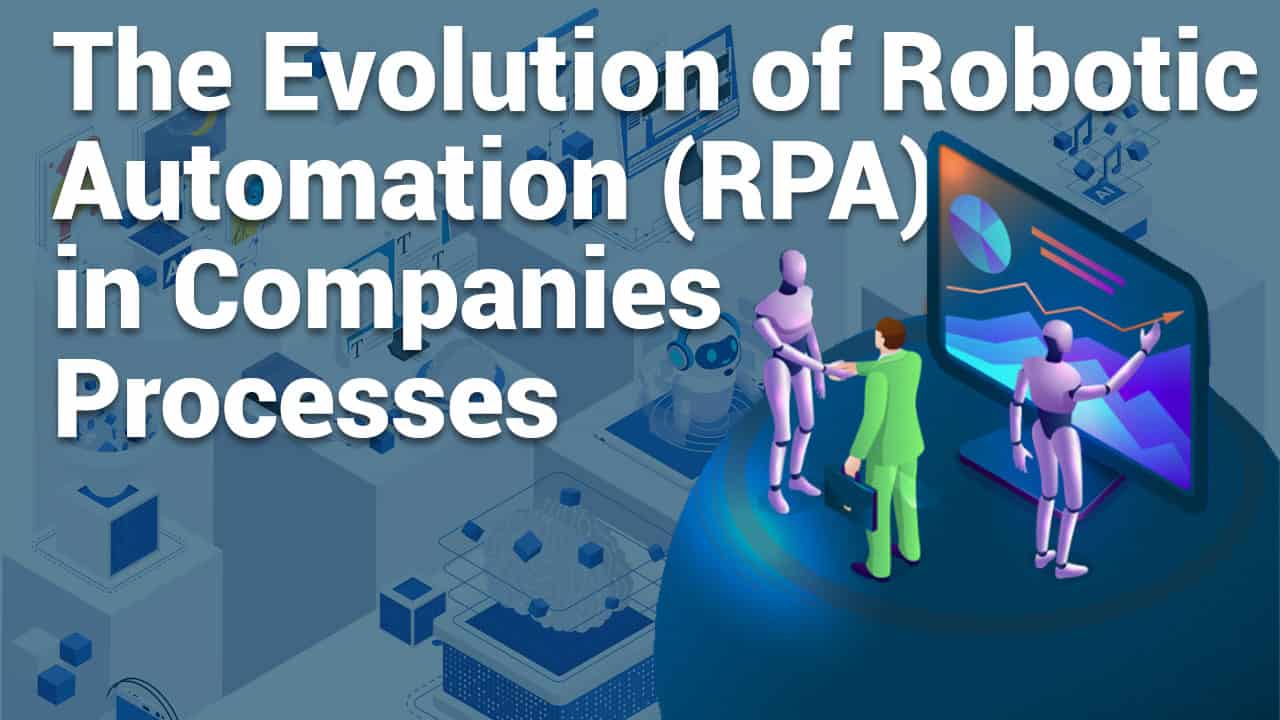
The progression of RPA in companies processes
What role does RPA play In progression of companies processes? In today’s fast-paced business environment, RPA has become a key driving force behind operational efficiency and productivity. As companies strive to stay competitive and meet the evolving demands of consumers, the adoption of automated processes has emerged as a crucial strategy. Automation not only streamlines repetitive tasks but also allows organizations to allocate their resources more effectively, enabling a focus on innovation and growth.
Amidst the landscape of automation solutions, Robotic Process Automation (RPA) has garnered significant attention for its transformative impact on company processes. With its ability to mimic human actions and automate mundane tasks, RPA presents a promising opportunity for businesses to optimize their operations and elevate overall performance. Understanding the intricate role of RPA within company processes is essential for harnessing its full potential and leveraging it as a catalyst for sustainable growth and development. By delving into the nuances of RPA implementation, businesses can unlock new possibilities for enhancing efficiency, reducing operational costs, and improving the overall quality of services provided. In this article, we will delve deeper into the role that RPA plays in the progression of company processes, highlighting its benefits, challenges, and future implications.
#1 Understanding RPA

1.1 Definition and core principles of Robotic Process Automation
Robotic Process Automation (RPA) refers to the deployment of software robots or ‘bots’ that mimic human interactions with digital systems to execute rule-based tasks. These bots are programmed to perform repetitive, mundane, and rules-driven processes, allowing businesses to automate a wide range of operational activities. RPA operates based on predefined rules and structured data, enabling the seamless execution of tasks across various applications, systems, and databases.
1.2 How RPA differs from traditional automation methods
What distinguishes RPA from traditional automation methods its capacity to work across multiple applications without the need for complex integration. Unlike traditional automation, which typically involves the use of complex scripts and codes tailored to specific applications, RPA operates through a user interface, enabling it to interact with various software and systems just as a human user would. This flexibility and adaptability make RPA an attractive solution for businesses seeking quick and efficient automation implementation.
1.3 Benefits of implementing RPA in business operations
The implementation of RPA in business operations offers a plethora of benefits. Firstly, RPA enhances operational efficiency by minimizing the occurrence of errors that may arise from manual data entry and processing. By ensuring a higher level of accuracy and precision, RPA helps businesses maintain data integrity and consistency, thereby fostering a more reliable and effective decision-making process. Additionally, RPA enables significant time and cost savings by expediting processes that would otherwise demand substantial manual labor. This efficiency boost allows employees to focus on more complex and strategic tasks, thereby improving overall productivity and resource utilization within the organization. Moreover, RPA facilitates enhanced compliance adherence by ensuring consistent adherence to regulatory guidelines and protocols, reducing the risk of non-compliance-related penalties and errors.
#2 Integrating RPA in Company Processes

2.1 Identifying areas suitable for RPA implementation
Identifying areas suitable for RPA implementation requires a comprehensive analysis of existing processes to pinpoint tasks that are rule-based, repetitive, and time-consuming. Processes such as data entry, invoice processing, report generation, and customer service inquiries often present ripe opportunities for RPA integration. Additionally, tasks that involve data validation, information transfer between systems, and data migration can benefit significantly from RPA, streamlining operations and reducing the margin for error.
2.2 Challenges and considerations in adopting RPA
While adopting RPA can yield substantial benefits, businesses must navigate certain challenges and considerations. One primary challenge lies in ensuring a seamless integration of RPA with existing systems and workflows, as inadequate integration can lead to disruptions and inefficiencies. Moreover, the initial investment and setup costs associated with RPA implementation can pose financial challenges for some organizations, necessitating a comprehensive cost-benefit analysis before adoption. Furthermore, the need for continuous monitoring and maintenance to ensure the smooth functioning of RPA systems demands dedicated resources and expertise. Additionally, addressing potential resistance from employees who may fear job displacement or changes in their roles is crucial for fostering a positive reception to RPA within the workforce.
2.3 Successful case studies illustrating the integration of RPA in different industries
Successful case studies across various industries exemplify the profound impact of integrating The progression of RPA into company processes. In the banking sector, RPA has revolutionized the processing of loan applications and customer inquiries, enabling faster response times and improved customer experiences. Similarly, within the healthcare industry, RPA has streamlined administrative tasks, such as patient data management and billing, allowing healthcare professionals to allocate more time to patient care. Additionally, in the retail sector, RPA has facilitated the automation of inventory management, order processing, and customer support, leading to enhanced operational efficiency and a more seamless customer journey. These case studies underline the versatility of RPA and its ability to drive positive transformations in diverse business environments, showcasing its potential for revolutionizing operational processes across multiple sectors.
#3 Enhanced Efficiency and Productivity with RPA

3.1 Streamlining repetitive tasks and minimizing errors through RPA
The progression of RPA plays a pivotal role in streamlining repetitive tasks and minimizing errors within company processes. By automating routine activities such as data entry, form filling, and report generation, RPA eliminates the risk of human errors, ensuring consistent and accurate results. This enhanced precision not only reduces the likelihood of costly mistakes but also fosters a more reliable and efficient workflow, enabling employees to focus on tasks that demand critical thinking and creativity.
3.2 Impact of RPA on workforce productivity and job roles
The integration of RPA can significantly impact workforce productivity and job roles, reshaping the nature of tasks performed by employees. While RPA automates repetitive and rule-based activities, it empowers employees to engage in more strategic and value-driven initiatives that require human ingenuity and problem-solving skills. By relieving employees of monotonous and time-consuming tasks, RPA enhances job satisfaction and fosters a more dynamic work environment, promoting employee engagement and creativity. Moreover, RPA encourages upskilling and reskilling initiatives, allowing employees to develop proficiencies in areas that complement and synergize with the automated processes, fostering a more agile and adaptable workforce.
3.3 Cost-efficiency and time-saving advantages of RPA implementation
The implementation of RPA offers notable cost-efficiency and time-saving advantages for businesses. By expediting processes that would typically require extensive manual labor, RPA enables companies to achieve higher operational output within shorter timeframes, thus boosting overall productivity. Additionally, the reduction in error rates leads to decreased costs associated with error rectification, enhancing cost-efficiency and minimizing financial losses. Furthermore, the time saved through RPA implementation allows organizations to allocate resources more effectively, enabling a focus on strategic initiatives and the exploration of new business opportunities. RPA’s ability to enhance operational efficiency and productivity while minimizing costs and saving time underscores its significant contribution to sustainable business growth and development.
#4 RPA and Business Growth

4.1 Leveraging RPA for scalability and business expansion
Leveraging RPA for scalability and business expansion is instrumental in facilitating the seamless management of increased workloads and operational demands. By automating core processes and workflows, businesses can accommodate growing complexities without compromising operational efficiency or quality. RPA enables organizations to scale their operations swiftly and efficiently, ensuring that increased demands do not hinder the delivery of consistent and high-quality products or services. This scalability empowers businesses to adapt to evolving market dynamics and expand their market presence without significant operational constraints.
4.2 Improving customer satisfaction and experience through RPA
The progression of RPA plays a vital role in improving customer satisfaction and experience by enabling faster response times and streamlined service delivery. Through the automation of customer support tasks, order processing, and inquiries, RPA ensures prompt and accurate responses to customer needs, fostering a more positive and seamless customer journey. By reducing response times and minimizing errors, RPA enhances customer satisfaction, ultimately contributing to improved brand loyalty and positive customer relationships. Additionally, the enhanced efficiency and accuracy brought about by RPA contribute to an overall improved customer experience, solidifying the company’s reputation and competitive edge in the market.
4.3 RPA’s role in fostering innovation and digital transformation within companies
RPA serves as a catalyst for fostering innovation and digital transformation within companies. By automating repetitive and mundane tasks, The progression of RPA allows businesses to reallocate resources toward fostering a culture of innovation and creativity. Employees are encouraged to engage in strategic thinking and problem-solving, leading to the development of innovative solutions and the exploration of new business opportunities. Moreover, RPA serves as a foundation for digital transformation initiatives, facilitating the integration of advanced technologies and digital solutions within the organization. This integration not only enhances operational efficiency but also positions the company at the forefront of technological advancement, enabling it to adapt to changing market trends and consumer preferences. RPA’s role in fostering innovation and digital transformation is instrumental in shaping a resilient and future-ready business ecosystem, poised for sustainable growth and success.
#5 Overcoming Challenges and Risks

5.1 Potential drawbacks and risks associated with RPA implementation
Despite its numerous benefits, RPA implementation is not without its challenges and potential risks. One of the primary concerns is the risk of technical glitches or system failures, which can disrupt operations and lead to potential downtime. Additionally, the lack of proper governance and control mechanisms may result in security vulnerabilities, compromising sensitive data and exposing the organization to potential cyber threats. Moreover, over-reliance on RPA without considering the broader strategic implications can lead to a narrow focus on automation, overlooking the importance of holistic business transformation. It is essential to be mindful of these drawbacks and risks to ensure the effective and sustainable integration of RPA within company processes.
5.2 Strategies for mitigating risks and ensuring the smooth integration of RPA
5.3 Balancing automation with human-centric processes for sustainable growth
Balancing automation with human-centric processes is critical for achieving sustainable growth and fostering a harmonious work environment. While RPA enhances operational efficiency, it is essential to preserve human involvement in tasks that demand critical thinking, creativity, and emotional intelligence. Encouraging collaboration between automated systems and human employees fosters a culture of innovation and continuous improvement, leveraging the strengths of both automation and human capabilities. By striking a balance between automation and human-centric processes, businesses can ensure a holistic approach to growth that values both technological advancement and the human element within the organization.
#6 Future of RPA in Company Processes

6.1 Predictions and trends shaping the future of RPA
Predictions and trends shaping The progression of RPA indicate a continued surge in its adoption across various industries, with a focus on more advanced and intelligent automation capabilities. The integration of artificial intelligence (AI) and machine learning algorithms into RPA systems is expected to enhance its cognitive abilities, enabling the automation of complex decision-making processes and tasks that involve unstructured data. Moreover, the emphasis on hyper-automation, which combines RPA with other advanced technologies, is anticipated to revolutionize the automation landscape, propelling businesses toward unprecedented levels of efficiency and productivity.
6.2 Evolving technologies and their impact on the development of RPA
Evolving technologies, such as AI, natural language processing (NLP), and cloud computing, are playing a pivotal role in the development of RPA. The convergence of RPA with AI technologies is fostering the creation of intelligent automation solutions that can adapt to dynamic environments and self-learn, enabling more sophisticated and context-aware decision-making. The integration of cloud-based RPA solutions is facilitating greater accessibility and scalability, allowing businesses to implement and manage RPA systems more efficiently and cost-effectively.
6.3 Anticipated advancements and innovations in the RPA landscape
Anticipated advancements and innovations in the RPA landscape revolve around the continual refinement of automation capabilities and the expansion of RPA’s applicability across diverse business functions. The development of enhanced analytics and reporting features within RPA systems is expected to provide businesses with valuable insights and data-driven recommendations for process optimization and performance enhancement. Furthermore, the integration of RPA with Internet of Things (IoT) technologies is anticipated to enable the automation of physical processes and the management of interconnected devices, paving the way for a more interconnected and automated business ecosystem. The progression of RPA and the future holds the promise of unprecedented technological advancements and transformative possibilities, reshaping the way businesses operate and driving sustainable growth and innovation.
Conclusion:
Throughout this exploration, The progression of RPA in optimizing company processes has become evident. By automating repetitive tasks, minimizing errors, and enhancing overall efficiency, RPA has emerged as a key driver of operational excellence and business productivity. Its ability to streamline workflows and free up valuable human resources has led to significant improvements in various industries, demonstrating its transformative potential within modern business environments.
Emphasizing the significance of adapting to technological advancements is paramount in today’s competitive landscape. Businesses that proactively embrace and integrate innovative technologies such as RPA are better positioned to stay ahead of the curve and meet the evolving demands of the market. The integration of RPA not only facilitates operational efficiency but also fosters a culture of innovation and adaptability, enabling businesses to navigate complex challenges and seize new opportunities for growth and development.




